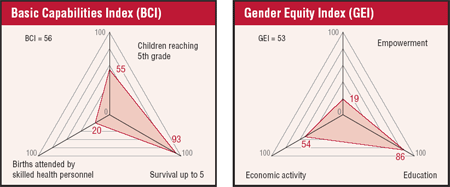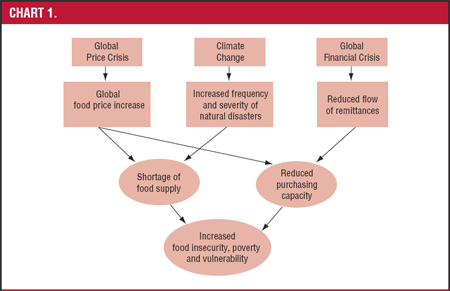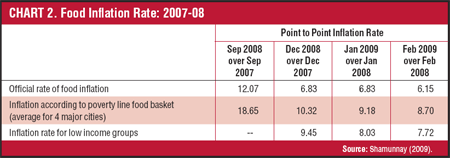More poverty, vulnerability and food insecurity
More poverty, vulnerability and food insecurity
Taifur Rahman
Arifur Rahman
Unnayan Shamannay
Poverty, vulnerability and food insecurity have increased in Bangladesh. The high price of food grains and the high level of inflation have led an additional 12.1 million people into poverty. There is increased frequency and severity of natural disasters. Two consecutive floods, plus Cyclone Sidr, together with the global price of food have led to food supply problems. It is the poorest and the female-headed households who are worst hit by the hike in prices for basic goods.
 |
Since its independence in 1971, Bangladesh pursued an inward looking development strategy with excessive government intervention in every aspect of economic activity. With the vision of a socialist type of agriculture, cooperative farming was encouraged while the procurement and distribution of seed, fertilizers, pesticides and all sorts of agricultural equipment was controlled by the Government. A series of measures, quantitative restrictions, highly differentiated tariff rates (ranging from 0% to 400%), and huge subsidies, along with an overvalued exchange rate, were put in place to protect domestic farms from competition. This restrictive environment was reinforced by domestic market policy interventions in the form of credit ceilings, arbitrary licensing and price controls.
These policies did not result in a sustained increase of production and productive efficiency; on the contrary, the gap between demand for and supply of agricultural products widened over the years. To find a way out of this crisis in the 1980s, the country pursued a policy shift away from state interventionism to more market-oriented policies which translated into sectoral policies that supported macroeconomic liberalization. Reform measures adopted included the rationalization of tariffs, the liberalization of investment in irrigation, the privatization of trade in fertilizers, agricultural machinery imports, seed delivery and food distribution systems, as well as management of agricultural research and extension systems. Moreover, reforms in farming led to a shrinking role of the Government; this was reflected in the distribution of goods, the reduction of subsidies, the liberalization of markets with producers' price incentives, the gradual elimination and narrowing down of the public grain distribution system, price stabilization through open tender procurement policies and the liberalization of food grain imports by the private sector.
The liberalization efforts were not confined to the agricultural sector. The whole economy began to go through all-out liberalization, particularly after the early 1990s, and became one of the most rapidly liberalized in the world. Although some claim that this was done too rapidly, the World Bank observed, “While trade liberalization occurred in fits and starts in Bangladesh, stronger and more decisive commitment to trade liberalization was seen in the majority of the rest of the world. As a result Bangladesh lags behind on most measures of trade openness. Even after the reduction in nominal protection in the financial year 2007 budget, Bangladesh has the highest level of trade protection in the region, which itself is the most trade restrictive region in the world”.1
Despite mounting pressure for more liberalization, the results of past liberalization measures must also be assessed. Did common people benefit from the process of liberalization or were the only beneficiaries some booming multinational giants? One of the major consequences of the all-out reforms has been increased dependency on imports, including agricultural products. As a result, despite being an agricultural nation, the country has been losing control of the prices of many ordinary products that people need every day.
The impact of the global crises
The diagram below illustrates the impact of the inter-related global crises in climate change, commodity prices and economic and financial crises on poverty and food insecurity.
 |
Climate change. Bangladesh tops the list of countries worst affected by climate change. One of the recent changes that the country is facing is the increased frequency and severity of natural disasters. Cyclone Sidr, which hit the Bangladesh coastal belt in 2007, was one of the most devastating disasters in the history of the country, resulting in a huge loss in natural resources and, more importantly, contributing to one of the major food shortages since the 1974 famine. This coincided with peaking global food and commodity prices and an unprecedented shortage of food supplies around the world.
Sidr and its impact on food insecurity constitute only one example of the many problems Bangladesh faces as a result of climate change. The changes in seasonal patterns and temperature have a negative impact on agricultural yields and on production costs.2 On the one hand the country is struggling to produce the food it requires, and on the other the price of food remains high due to the increased costs of production.
Climate change is particularly impacting some poverty pockets in Bangladesh, which are now being considered also as ‘climate change hotspots’. The poor and extremely poor people living in these ecologically vulnerable pockets are facing increasingly harder realities due to changed patterns of nature. For example, in the northwest region the severity of soil erosion caused by river flows has increased substantially making poor inhabitants much more vulnerable to poverty and hunger. Similarly, in the northeast water basins, the changed timings of emergence and retreat of water are having significant negative impacts on agriculture and food production.
Food prices. In addition to the massive loss in domestic production in 2007 and 2008 following two devastating floods and cyclone Sidr, another major contributor was the global rise in food and commodity prices. The food inflation rate for the poor was much higher, exceeding 20% towards the end of 2007. Chart 2 presents the official food inflation rates, including the overall rate and the rate estimated for the poverty line food basket. It is worth to mention that although the bumper crops in 2008 and 2009 led to aggregate food supply and that, as a result of close monitoring by the Government, food prices, particularly those of rice and edible oil went down significantly, the problem remains in distribution. The level of food insecurity among the poorest households, particularly in the ecologically vulnerable areas, has not been solved. Moreover, the high costs of production have lowered the farmers’ margin. A study by the Dhaka-based think tank Centre for Policy Dialogue (CPD) indicates that 48.5% of people in Bangladesh do not have enough money to buy basic food items such as rice, compared to 40% in 2005.3 The CPD report stresses that, “as a consequence of high prices of food grains and high level of general Inflation, an additional 12.1 million people (8.5% of total population) became poor, between January 2005 and March 2008”.
Inflation. Starting in late 2007, the inflation rate in Bangladesh, which had been practically unseen during the last decade, reached double digits – hitting 11.21% in November, according to the Bangladesh Bureau of Statistics. The burden of inflation fell disproportionately on the poorer sectors of society. Some studies have showed that it was the poorest and the female-headed households who were hit the most from the hike in prices of essential goods.4
 |
The net result of all this is that the extent of extreme poverty, vulnerability and food insecurity might have increased. It is feared that the rate of extreme poverty may have actually increased, aggravated by continuing food insecurity, especially in the pockets of extreme poverty and vulnerability.
1 World Bank. Bangladesh: Strategy for Sustained Growth, Bangladesh Development Series, 2007.
2 European Parliament. “Climate Change Impacts and Responses in Bangladesh”, 2008. Available from: <www.europarl.europa.eu/activities/committees/studies/download.do?file=19195>.
3 See: <www.idsa.in/publications/stratcomments/AnandKumar300708.htm>.
4 UNICEF. “A Matter of Magnitude. The Impact of the Economic Crisis on Women and Children in South Asia”, 2009. Available from: <www.unicef.org/rosa/Complete_Matter_of_Magnitude.pdf>.


